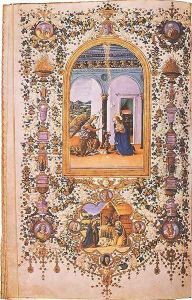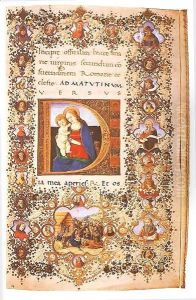Francesco Antonio del Cherico Paintings
Francesco Antonio del Cherico, born in 1445, was an eminent Italian Renaissance illuminator and manuscript decorator, whose lifetime contribution to the arts spanned from the mid-15th century until his death in 1480. Often overshadowed by the towering figures of his time, del Cherico carved a niche for himself through his distinctive style and dedication to the craft of illumination, a form of art that involves the embellishment of texts with intricate designs, borders, and illustrations. Operating primarily in Florence, Italy, a hub for artistic innovation during the Renaissance, del Cherico was part of a vibrant community of artists and was deeply influenced by the cultural resurgence of classical antiquity that defined the era.
Despite the limited records on his early life, it is known that Francesco Antonio del Cherico apprenticed under a master illuminator, which was customary at the time for young artists. This foundational period was crucial in shaping his artistic vision and skills, which later evolved into a mature style characterized by its elegance, attention to detail, and the harmonious integration of text and decoration. His works often featured elaborate initial letters, ornate borders filled with floral and geometric patterns, and vivid illustrations that brought the manuscripts to life. These attributes made his creations highly sought after by the Florentine elite, including prominent families and religious institutions, who commissioned him to decorate liturgical texts and personal devotional books.
Del Cherico's contribution to the art of illumination was significant in several ways. Firstly, his work represents a key chapter in the history of book decoration, showcasing the transition from the medieval manuscript tradition to the more individualized and secular approach of the Renaissance. Secondly, his ability to blend classical themes with contemporary religious and secular narratives provided a visual commentary on the intellectual and cultural currents of his time. Despite the advent of printing press technology during his lifetime, which led to a decline in manuscript production, del Cherico's work maintained its value and appeal, emphasizing the enduring importance of handcrafted artistry in an increasingly mechanized world.
Francesco Antonio del Cherico's death in 1480 marked the end of a relatively short, but impactful career. Today, his surviving works are preserved in several major collections and libraries around the world, serving as a testament to his artistic legacy. They continue to be studied and admired for their beauty, craftsmanship, and as windows into the vibrant cultural life of Renaissance Florence. Through his contributions to the art of illumination, del Cherico ensured his place in the annals of art history, not just as a skilled craftsman, but as an artist who captured the spirit of his age.

